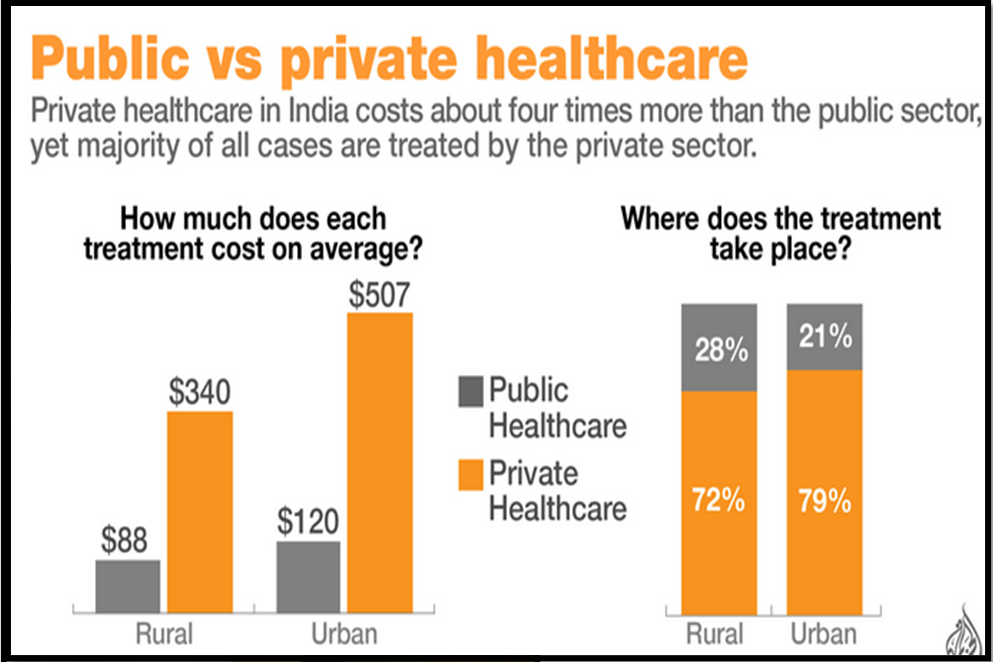THE COST OF HEALTH
SYLLABUS:
- GS 3: Indian Economy and issues relating to planning, mobilization, of resources, growth, development and employment.
- Inclusive growth and issues arising from it.
Focus:
- Capping costs in private sector is important but healthcare can’t do without adequate state investment.
Healthcare Costs and Impoverishment
- Healthcare expenses can quickly become overwhelming, leading to financial crises for families.
- Out-of-pocket costs can cause impoverishment, making it one of the most severe societal issues.
- High healthcare costs fuel resentment and occasionally violence against healthcare workers.
- The Supreme Court of India has addressed the need for regulation on healthcare pricing.
- Families often reach out to doctors in desperation to mitigate these expenses.
Supreme Court’s Intervention
- The Supreme Court considered imposing CGHS rates on all hospitals as a temporary measure.
- This action was in response to a PIL that requested the regulation of hospital charges nationwide.
- The court’s potential involvement raises questions about its effectiveness in an area where previous government actions have faltered.
- Resistance is expected from the healthcare industry and influential doctors.
- The court’s move is a significant but small step towards making healthcare affordable.
Publicly Funded Healthcare Systems
- A publicly funded health system is essential for providing timely and effective care free of charge.
- Universal healthcare systems ensure no one pays at the point of care, funded by taxpayer money.
- The intention is for the wealthy to subsidize the health costs of the poor.
- Effective public healthcare was an initial goal post-Independence in India.
- However, underfunding and neglect have allowed private sectors to thrive, undermining public healthcare.
Challenges with Private Healthcare in India
- Healthcare inherently involves unpredictability and empathy, not easily managed by market rules.
- India’s healthcare sector remains one of the least regulated worldwide.
- There is significant co-option in the medical profession, with doctors owning hospitals and profiting from unnecessary treatments.
- Private hospitals offer high-tech and efficient care, attracting the middle class and even the economically disadvantaged.
- This leads to a problematic mix of excessive private care costs and suboptimal state care.
Importance of Private Care Providers and Start-ups in India’s Healthcare System:
- Penetration: Private medical sector serves as the primary source of healthcare for the majority of households in both urban (70%) and rural areas (63%), making it crucial for improving healthcare accessibility and efficiency.
- Poor Public Healthcare: With low quality and long waiting times in public hospitals, people seek better healthcare services, where the private sector can excel, especially if costs remain affordable.
- Affordability: Despite being a rapidly growing sector, fragmentation makes it challenging for patients to find affordable healthcare. Start-ups in digital healthcare and eHealth can help bridge this gap, making healthcare more accessible.
- Accessibility: Digital technology, exemplified by companies like Practo, facilitates easy access to medical specialists, patient reviews, and online appointment booking, addressing the issue of accessibility in healthcare.
- Availability: In rural areas, healthcare services are often scarce, leaving quacks as the only option. Training and mainstreaming them can enhance healthcare accessibility in these regions.
- Investment: The healthcare system in India faces challenges due to inadequate funding for preventive healthcare, professional training, and infrastructure development, particularly in rural areas. Start-ups can contribute to addressing these challenges by attracting investment and innovation.
Government Role and Health Insurance
- Government initiatives like mass insurance schemes attempt to integrate private sector resources to provide care.
- Examples include Aarogyasri and Rajiv Gandhi Jeevandayee Arogya Yojana, with the national AB-PMJAY scheme covering nearly half the population.
- The Clinical Establishment Act of 2010 aimed to regulate health establishments and standardize costs.
- However, implementation has been lax or inconsistent across states.
- Private healthcare often resists cost control measures, especially when business is thriving.
The Need for State Investment in Healthcare
- Historical attempts at controlling private healthcare costs have mostly failed.
- Supreme Court’s intervention might prompt some changes, but significant challenges remain.
- Effective healthcare improvement requires substantial state investment in health funding.
- Current healthcare funding by the Indian state is among the lowest globally, complicating reforms.
- Healthcare is often overshadowed in political agendas by more immediate or emotive issues.
Recent Government Initiatives for Healthcare Sector Growth:
|
Source:Indian Express
Mains Practice Question:
“Despite numerous judicial interventions and policy reforms, the high cost of healthcare and the underfunded state facilities continue to burden the Indian populace.”




